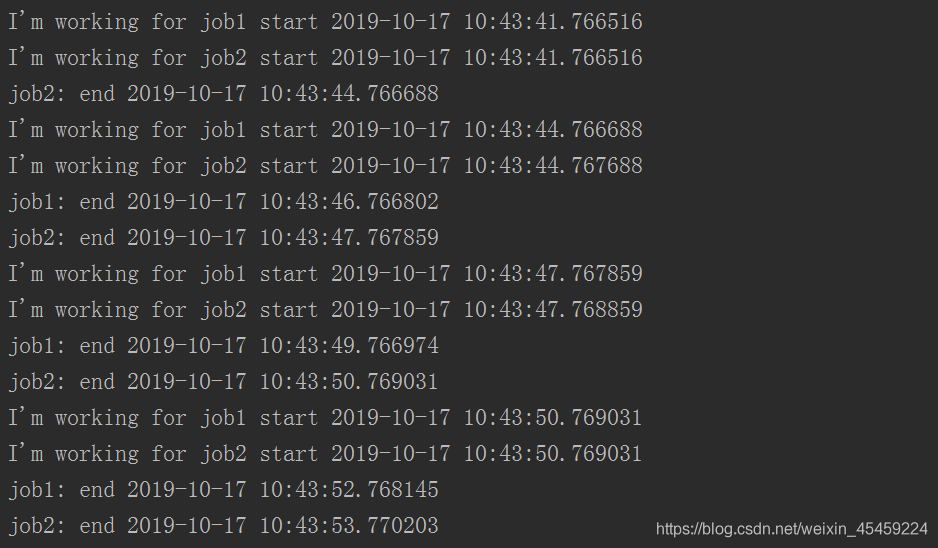python实现定时器的5种方法
作者:小胖_@
本文主要介绍了python实现定时器的5种方法,文中通过示例代码介绍的非常详细,对大家的学习或者工作具有一定的参考学习价值,需要的朋友们下面随着小编来一起学习学习吧
1. 使用time,threading 模块
第一种:
代码实现:
# -*- coding:utf-8 -*-
import threading
import time
cancel_tmr = False
def start():
#具体任务执行内容
print("hello world")
def heart_beat():
# 打印当前时间
print(time.strftime('%Y-%m-%d %H:%M:%S'))
if not cancel_tmr:
start()
# 每隔3秒执行一次
threading.Timer(3, heart_beat).start()
if __name__ == '__main__':
heart_beat()
# 15秒后停止定时器
time.sleep(15)
cancel_tmr = True
第二种:
# -*- coding:utf-8 -*-
import threading
import time
exec_count = 0
def start():
print("hello world", exec_count)
def heart_beat():
print(time.strftime('%Y-%m-%d %H:%M:%S'))
global exec_count
exec_count += 1
# 执行15次后停止定时器
if exec_count < 15:
start()
threading.Timer(5, heart_beat).start()
if __name__ == '__main__':
heart_beat()
2. 使用datetime,threading 模块
要求:每天凌晨3点执行func方法。
代码实现:
# -*- coding:utf-8 -*-
import datetime
import threading
def func():
print("haha")
# 如果需要循环调用,就要添加以下方法
timer = threading.Timer(86400, func)
timer.start()
# 获取现在时间
now_time = datetime.datetime.now()
# 获取明天时间
next_time = now_time + datetime.timedelta(days=+1)
next_year = next_time.date().year
next_month = next_time.date().month
next_day = next_time.date().day
# print(next_time, next_year, next_month, next_day)
# 获取明天3点时间
next_time = datetime.datetime.strptime(str(next_year) + "-" + str(next_month) + "-" + str(next_day) + " 03:00:00", "%Y-%m-%d %H:%M:%S")
# print(next_time)
# # 获取昨天时间
# last_time = now_time + datetime.timedelta(days=-1)
# 获取距离明天3点时间,单位为秒
timer_start_time = (next_time - now_time).total_seconds()
print(timer_start_time)
# 54186.75975
# 定时器,参数为(多少时间后执行,单位为秒,执行的方法)
timer = threading.Timer(timer_start_time, func)
timer.start()
3. 使用time,schedule 模块 (执行单个任务)
schedule:一个轻量级的定时任务调度的库。
代码实现:
# !/usr/bin/env python
# -*- coding:utf-8 -*-
import schedule
import time
def job(text=""):
print(text, "I'm working...")
schedule.every().seconds.do(job, "每秒一次")
schedule.every(5).seconds.do(job, "五秒一次")
schedule.every(10).minutes.do(job, "10分钟一次")
schedule.every().hour.do(job, "1小时一次")
# 每天10:30执行
schedule.every().day.at("10:30").do(job)
# 每隔5到10天执行一次任务
schedule.every(5).to(10).days.do(job)
# 每周一的这个时候执行一次任务
schedule.every().monday.do(job)
# 每周三13:15执行一次任务
schedule.every().wednesday.at("13:15").do(job)
while True:
# run_pending:运行所有可以运行的任务
schedule.run_pending()
time.sleep(1)
4. 使用time,schedule 模块 (执行多个任务)
时间有冲突的执行多个任务
代码实现:
# -*- coding:utf-8 -*-
import schedule
import time
def job():
print("I'm working... in job1 start")
time.sleep(5)
print("I'm working... in job1 end")
def job2():
print("I'm working... in job2")
schedule.every(3).seconds.do(job)
schedule.every(3).seconds.do(job2)
while True:
schedule.run_pending()
time.sleep(1)
运行结果:

根据代码运行结果可以看出,schedule方法是串行的,代码中有时间冲突,所以执行完第一个任务,才会执行第二个任务,即任务二每隔3秒执行一次,而任务一执行时间是5秒。
如果不用多线程,则定时任务会不准确,因为任务会按照顺序执行,如果上一个任务比较耗时,则下一个任务就会"延误"
多线程并发运行多个任务
代码实现:
# -*- coding:utf-8 -*-
import datetime
import schedule
import threading
import time
def job1():
print("I'm working for job1 start", datetime.datetime.now())
time.sleep(5)
print("job1: end", datetime.datetime.now())
def job2():
print("I'm working for job2 start", datetime.datetime.now())
time.sleep(3)
print("job2: end", datetime.datetime.now())
def job1_task():
threading.Thread(target=job1).start()
def job2_task():
threading.Thread(target=job2).start()
def run():
schedule.every(3).seconds.do(job1_task)
schedule.every(3).seconds.do(job2_task)
while True:
schedule.run_pending()
time.sleep(1)
if __name__ == '__main__':
run()
代码运行结果:

5. 使用apscheduler 模块
apscheduler 模块详情介绍
代码实现
# -*- coding:utf-8 -*-
import time
import datetime
from apscheduler.schedulers.blocking import BlockingScheduler
def my_job(text="默认值"):
print(text, time.strftime('%Y-%m-%d %H:%M:%S', time.localtime(time.time())))
sched = BlockingScheduler()
sched.add_job(my_job, 'interval', seconds=3, args=['3秒定时'])
# 2018-3-17 00:00:00 执行一次,args传递一个text参数
sched.add_job(my_job, 'date', run_date=datetime.date(2019, 10, 17), args=['根据年月日定时执行'])
# 2018-3-17 13:46:00 执行一次,args传递一个text参数
sched.add_job(my_job, 'date', run_date=datetime.datetime(2019, 10, 17, 14, 10, 0), args=['根据年月日时分秒定时执行'])
# sched.start()
"""
interval 间隔调度,参数如下:
weeks (int) – 间隔几周
days (int) – 间隔几天
hours (int) – 间隔几小时
minutes (int) – 间隔几分钟
seconds (int) – 间隔多少秒
start_date (datetime|str) – 开始日期
end_date (datetime|str) – 结束日期
timezone (datetime.tzinfo|str) – 时区
"""
"""
cron参数如下:
year (int|str) – 年,4位数字
month (int|str) – 月 (范围1-12)
day (int|str) – 日 (范围1-31)
week (int|str) – 周 (范围1-53)
day_of_week (int|str) – 周内第几天或者星期几 (范围0-6 或者 mon,tue,wed,thu,fri,sat,sun)
hour (int|str) – 时 (范围0-23)
minute (int|str) – 分 (范围0-59)
second (int|str) – 秒 (范围0-59)
start_date (datetime|str) – 最早开始日期(包含)
end_date (datetime|str) – 最晚结束时间(包含)
timezone (datetime.tzinfo|str) – 指定时区
"""
# my_job将会在6,7,8,11,12月的第3个周五的1,2,3点运行
sched.add_job(my_job, 'cron', month='6-8,11-12', day='3rd fri', hour='0-3')
# 截止到2018-12-30 00:00:00,每周一到周五早上五点半运行job_function
sched.add_job(my_job, 'cron', day_of_week='mon-fri', hour=5, minute=30, end_date='2018-12-31')
# 表示2017年3月22日17时19分07秒执行该程序
sched.add_job(my_job, 'cron', year=2017, month=3, day=22, hour=17, minute=19, second=7)
# 表示任务在6,7,8,11,12月份的第三个星期五的00:00,01:00,02:00,03:00 执行该程序
sched.add_job(my_job, 'cron', month='6-8,11-12', day='3rd fri', hour='0-3')
# 表示从星期一到星期五5:30(AM)直到2014-05-30 00:00:00
sched.add_job(my_job, 'cron', day_of_week='mon-fri', hour=5, minute=30, end_date='2014-05-30')
# 表示每5秒执行该程序一次,相当于interval 间隔调度中seconds = 5
sched.add_job(my_job, 'cron', second='*/5', args=['5秒定时'])
sched.start()
到此这篇关于python实现定时器的5种方法的文章就介绍到这了,更多相关python 定时器内容请搜索脚本之家以前的文章或继续浏览下面的相关文章希望大家以后多多支持脚本之家!
